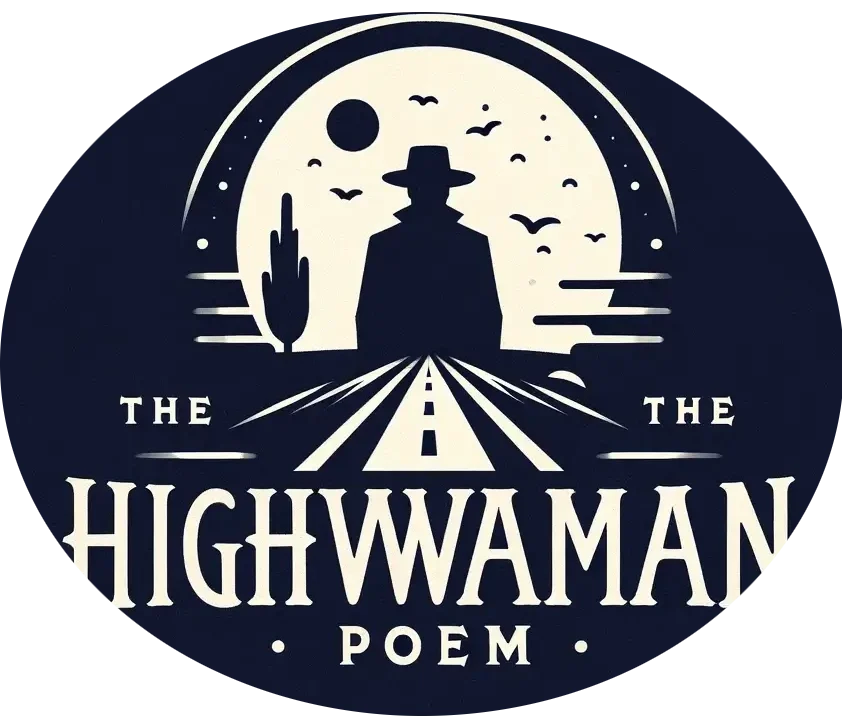“The Highwayman” by Alfred Noyes stands as a timeless classic poem that enthralls readers through its captivating storyline and vivid imagery. This analysis will delve into the summary, structure, and form of the poem, along with an examination of the various poetic techniques employed by Noyes.
The exploration will include an in-depth look at the moonlight symbolism, romantic imagery, and visual depictions that contribute to the enchanting nature of this work. Furthermore, a comparative study will be conducted to assess the impact of “The Highwayman” on poetry and its significance in the realm of literature.
Readers are invited to embark on this literary journey to uncover the beauty and profound depth of this enduring piece.
The Road Was A Ribbon Of Moonlight and Key Takeaways:
- Moonlight symbolizes romance, danger, and freedom in “The Highwayman“, adding depth to the poem’s imagery.
- Romantic imagery, including references to nature and emotion, creates a vivid and passionate atmosphere in “The Highwayman”.
- The visual descriptions in “The Highwayman” bring the story to life, immersing the reader in the setting and emotions of the characters.
Summary of ‘The Highwayman’
The poem ‘The Highwayman‘ narrates the poignant love tale of a charismatic highwayman and Bess, the daughter of the innkeeper, set against the backdrop of 18th-century England.
Tim the ostler, a helper at the inn, harbors secret affections for Bess. When the authorities under King George pursue the highwayman, Bess, in an act of bravery to alert him, tragically ends her own life by shooting herself.
Upon hearing the fatal gunshot that signifies Bess’s demise, the gallant highwayman rushes back to the inn, only to be ambushed by King George’s men.
The sorrowful culmination of events transpires as the highwayman meets his demise amidst a barrage of bullets, with Bess’s ethereal presence awaiting him in the realms beyond.
Structure and Form of ‘The Highwayman’
The poetic structure of ‘The Highwayman’ is defined by a series of stanzas that employ various literary techniques, such as alliteration and enjambment, to craft a rhythmic and captivating storyline. These stanzas exhibit a consistent rhyme scheme of AABB, where the second and fourth lines within each quatrain rhyme. Additionally, the poem adheres to a steady meter, predominantly featuring a trochaic rhythm that amplifies the narrative’s impact.
An illustrative instance within the text can be found in stanza three, where the recurring phrase ‘tlot-tlot, tlot-tlot‘ utilizes alliteration to mirror the sound of the horse’s hooves, intensifying the sense of urgency conveyed in the narrative. This literary device, coupled with the frequent use of enjambment, propels the reader forward through the poem’s vivid imagery and profound emotional resonance.
Imagery in ‘The Highwayman’
The imagery depicted in ‘The Highwayman’ assumes a pivotal role in vividly portraying the scenes, characterized by detailed descriptions of moonlight, the somber atmosphere encircling the inn-door, and the gusts of wind along the road.
Moonlight Symbolism
The moonlight depicted in ‘The Highwayman’ functions as a potent metaphor, symbolizing the transient and elusive nature of the characters’ love. Within the poem, the moonlight not only embodies the ephemeral quality of their affection but also enriches the narrative by infusing it with romantic and tragic undertones.
By illuminating the clandestine rendezvous and dramatic pursuits with a shimmering silver light, the moonlight heightens the emotional bond between the lovers while also hinting at the impending tragedy. Its otherworldly essence reflects the intense sentiments of the characters and the precariousness of their forbidden love, imbuing the narrative with themes of yearning, sacrifice, and inevitability that reverberate throughout the story.
Romantic Imagery
The romantic imagery in ‘The Highwayman’ is notably featured through the portrayal of the love-knot and various metaphors that emphasize the profound connection between the characters.
One notable instance is when the poet characterizes the love between the Highwayman and Bess as ‘But he loved the landlord’s daughter, The landlord’s red-lipped daughter‘. This evocative imagery not only conveys the depth of their affection but also paints a vivid picture in the reader’s imagination of the Highwayman’s sentiments towards Bess.
The moon plays a significant role in symbolizing their love, as evidenced in the lines ‘The moon was a ghostly galleon tossed upon cloudy seas,’ which amplifies the romantic ambiance of the poem.
Visual Descriptions
The poem utilizes visual descriptions to create a detailed portrayal of the setting, ranging from the dimly lit road winding through the countryside to the resonating sounds of horsehoofs.
These depictions effectively communicate a feeling of ominousness and enigma. For example, the verse ‘moonless night, with clouds to flee‘ establishes a chilling ambiance, heightening the eerie mood of the poem. The reference to ‘twisted trees that groan and sigh‘ animates a scenery that appears haunted and pulsating with its own spectral essence. Such vivid imagery plunges the reader into a realm of shadows and ambiguity, adding intricate layers to the poem’s haunting backdrop.
Poetic Techniques Used in ‘The Highwayman’
The poem “The Highwayman” showcases a rich array of poetic techniques, notably including alliteration, enjambment, personification, onomatopoeia, and repetition, all of which serve to elevate the poem’s lyrical quality.
Alliteration, as an illustrative instance, is deftly employed by the poet to establish a harmonious and rhythmic effect within the verses. The deliberate repetition of initial consonant sounds, as seen in phrases like “ghostly galleon” or “the moon was a ghostly galleon,” imbues the narrative with a melodious cadence, captivating the reader while enhancing the poem’s overall haunting ambiance.
Conversely, enjambment is utilized to cultivate a sense of continuity and fluidity in the structural composition of the poem. By allowing lines to seamlessly flow from one to the next, enjambment engages the reader in the unfolding drama of the Highwayman’s narrative, further immersing them in the unfolding storyline.
Analysis of ‘The Highwayman’
A detailed examination of ‘The Highwayman’ uncovers profound themes of love, loss, and mortality intricately interwoven into a gothic narrative that engrosses the reader.
Part I: Context and Themes
The initial section of ‘The Highwayman’ serves as an introduction, establishing themes of love and loss against the backdrop of 18th-century England. The poem commences with a detailed portrayal of a highwayman, a romantically idealized character from that period, attired in a lengthy coat and adorned hat, traversing the stormy night on horseback. The inn, characterized by its thatched roof and casement windows, acts as the stage for the ensuing narrative.
The introduction of Bess, the daughter of the innkeeper and the object of affection for the highwayman, contributes an emotional depth to the story. As the highwayman draws near to the inn, the groundwork is laid for a narrative exploring elements of passion, betrayal, and tragedy in the midst of societal unrest and upheaval.
Part II: Character Analysis and Plot Development
Section II of ‘The Highwayman’ provides an in-depth exploration of character analysis, with a particular focus on individuals such as Bess, Tim the ostler, and King George’s men. This section also scrutinizes the plot development that culminates in the story’s climax.
Within the narrative, intricate relationships and motivations define the interactions among Bess, Tim, and the soldiers, shaping the progression of events. Bess’s steadfast affection for the Highwayman initiates a series of consequential actions, while Tim’s act of betrayal sets a tragic sequence in motion. The relentless pursuit by King George’s men heightens the narrative’s tension, introducing an element of peril and immediacy.
These interplays not only propel the plot forward but also heighten the stakes, imparting a palpable sense of impending calamity that captivates readers and sustains their engagement.
Comparative Study: ‘The Highwayman’ in Literature
A comparative analysis of ‘The Highwayman’ with other literary works elucidates its distinctive amalgamation of gothic narrative and poignant themes, thereby distinguishing it within the literary sphere.
One notable comparison can be drawn with Edgar Allan Poe’s ‘The Raven,’ renowned for its somber and brooding ambiance. In contrast to ‘The Raven,’ which primarily concentrates on profound psychological exploration, ‘The Highwayman’ emerges for its inclusion of romantic elements and a tragic love narrative. Delving into themes of love, betrayal, and sacrifice, ‘The Highwayman’ employs vivid imagery and emotive storytelling techniques. This juxtaposition underscores Noyes’ adeptness in interweaving elements of romance and tragedy within a suspenseful plot, ultimately crafting a timeless work that resonates with readers across various generations.
Impact of ‘The Highwayman’ on Poetry
The influence of ‘The Highwayman’ on poetry is significant, as Alfred Noyes’ expert writing style and exploration of universal themes have left a lasting impact on generations of poets.
Many poets have found inspiration in Noyes’ adept use of vivid imagery and evocative language within ‘The Highwayman’. The poem’s themes of love, betrayal, and tragic sacrifice continue to strike a chord with contemporary writers, who strive to evoke similar emotional depths within their own literary works.
Noyes’s pioneering narrative technique, characterized by compelling storytelling and unexpected plot developments, has been imitated and modified by subsequent poets seeking to craft engaging and memorable narratives. ‘The Highwayman’ stands as a cornerstone for poets endeavoring to infuse their compositions with passion, romanticism, and an enduring appeal.
Frequently Asked Questions
1. What is the significance of the road being described as a “ribbon of moonlight” in the poem “The Highwayman”?
The phrase “ribbon of moonlight” evokes a sense of romance and enchantment, setting the tone of the poem as a tragic love story. It also symbolizes the connection between the highwayman and Bess, as the road serves as a pathway for their forbidden love.
2. How does the imagery of the moon in “The Highwayman” contribute to the overall theme of the poem?
The moon is a recurring symbol throughout the poem, representing the passage of time and the cyclical nature of life and death. It also serves as a symbol of the highwayman’s restless spirit, always returning to the same spot where he was killed.
3. What other elements of nature are described in the poem “The Highwayman”?
Along with the moon, the poem also mentions the wind, rain, and stars. These natural elements not only add to the romantic and dramatic atmosphere of the poem, but also serve as a reflection of the characters’ emotions and fates.
4. How does the use of sensory imagery enhance the reader’s experience of the poem?
By incorporating vivid descriptions of sight, sound, and touch, the poem creates a more immersive experience for the reader. This allows them to better visualize the events and emotions in the story and connect with the characters on a deeper level.
5. How does Bess’s appearance and actions in the poem contribute to the use of imagery?
Bess is described as having “lips like cherries” and “dark in her hair like the night.” These descriptions not only add to the romantic and sensual atmosphere of the poem, but also create a contrast between her beauty and the violence of her actions, such as her eventual suicide.
6. What is the significance of the symbol of the red ribbon in “The Highwayman”?
The red ribbon symbolizes the connection between the highwayman and Bess, as it is described as the only color in the otherwise dark and dreary landscape. It also represents their love and passion, as well as Bess’s loyalty to the highwayman even in death.

